COMPARATIVE STUDY OF PERCEPTUAL MOTOR COORDINATION BETWEEN INTELLECTUAL CHILDREN AND CHILDREN WITH MILD INTELLECTUAL DISABILITY
Abstract
The purpose of the study was to determine comparison between perceptual motor abilities of intellectual children and children with mild intellectual disability. 30 intellectual children from D. A. V. Public School, Patiala and 30 children with mild intellectual disability from Patiala school for the Deaf, Saifdipur were selected randomly as the subjects for this study. The necessary data was collected by carrying the measurements. In order to analyze the scores of the selected dimension of intellectual children and children with mild intellectual disability, the decrypted analysis technique was used. Further to find our significant comparison between the scores of subjects on selected dimension of intellectual children and children with mild intellectual disability. The ‘t’ test was employed for testing of the hypothesis the level of significance was set at 0.05 level.
Downloads
References
Andrew Graham, Greg Reid. (2013). Physical Fitness of Adults with an Intellectual Disability: A 13-Year Follow-up Study. Research Quaterly for Exercise and Sport, 71, 152-161.
Bell, A.J., & Bhate, M.S. (1992). Prevalence of overweight and obesity in Down’s syndrome and other mentally handicapped adults living in the community. Journal of Intellectual Disability Research, 36, 359-364.
Binsted G., Chua R., Helsen W. & Elliott D. (2001) Eye– hand coordination in goal-directed aiming. Human Movement Science, 20, 563–85.
Carmeli E., Bar-Yossef T., Ariav C., Levy R., Liebermann D.G. (2008). Perceptual-motor coordination in persons with mild intellectual disability. Disability and Rehabilitation, 30(8), 323-329.
Carmeli, E. Merrick, J. Kessel, S. Bar –Chad, S. (2004). A comparisonbetween older persons with Down syndrome and a controlgroup: clinical characteris-tics, funtional status and Connolly H, Michael BT. Performance of retarded children, with and without Down’s syndrome, on the Bruininks Oseretsky Test of Motor Proficiency. Physical Therapy, 66, 344–348.
Cheryl Missiuna, Sandra Moll, Gillian King, Debra Stewart, Kathryn Macdonald. (2008). Life Experiences Of Young Adults Who Have Coordination Difficulties. Canadian Journal Of Occupational Therapy, 75, 157-166.
Huette S., Kello C.T., Rhodes T., Spivey M.J. (2013). Drawing from memory: handeye coordination at multiple scales. Public Library of Science, 8(3), 58-64.
Hung Y.C., Casertano L., Hillman A., Gordon A.M. (2011). The effect of intensive bimanual training on coordination of the hands in children with congenital hemiplegia. Research in Developmental Disabilities, 32(6), 2724-2731.















